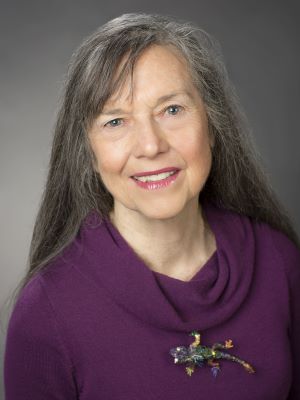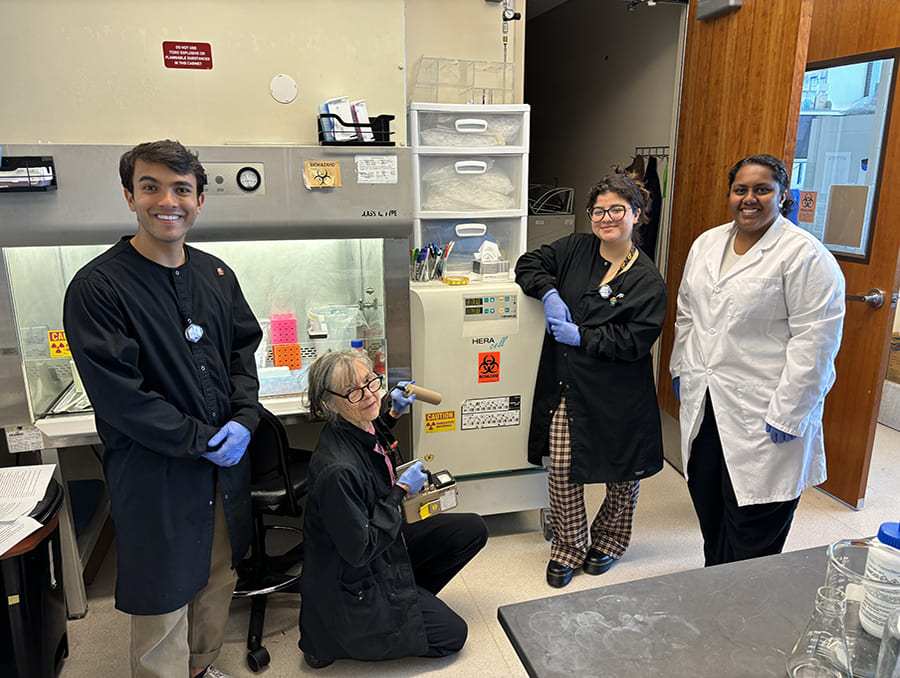Dorothy Hudig, Ph.D., professor of immunology, and her research team at the University of Nevada, Reno School of Medicine (UNR Med), have been recognized as this year’s recipient of the Excellence in Laboratory Safety Award for consistently having one of the best-managed labs on campus.
“Dr. Hudig has maintained a productive research group while working safely with a wide variety of hazardous materials for more than four decades,” said Keith Kikawa, Ph.D., senior laboratory safety specialist at Environmental Health & Safety (EH&S). "She is a pioneer in driving the implementation of new safety controls like ensuring hazardous chemical storage is secure in our seismically active area and pushing for updated hands-on training for stair-lift devices in cases of emergency. Dr. Hudig also involves her staff and students in assessments and makes a clear effort to promote a culture of laboratory safety.”
 Dorothy Hudig, Ph.D.
Dorothy Hudig, Ph.D.With over 40 years of experience working at the University, Hudig has remained committed to ensuring the well-being of those working in the lab, a dedication that stemmed from her days as a graduate student when lab safety took on a personal significance to her.
“As a graduate student, my hair caught on fire from an open Bunsen burner,” Hudig reminisced. “A lab mate had to grab an extra lab coat and snuff me out! It was an unforgettable experience.”
From that moment, Hudig embarked on a lifelong mission to champion safety in the lab. Now, as a principal investigator (PI), she leads by example, ensuring that her research team adheres to the highest standards of safety protocols.
“As the PI, I believe that the leader has to conform with safety measures and also allow the time and training for team members to conform to the rules,” Hudig said. “Sometimes, safety takes a bit more time. I half-jokingly say I will fire anyone standing on a swivel lab chair or washing dishes without gloves. When procedures are violated, I explain the logic behind the rules. I also adhere to the buddy system and have two people in the lab at night when experiments with biohazards and radiation run into late hours.”
Within the collaborative framework of Hudig's safety initiatives, proactive measures are not only about addressing current concerns but also about preemptively strategizing for potential challenges.
“We talk about issues we have had in the past and how to avoid reoccurrences of the problems,” Hudig said. “An example is the explosion of a vial of frozen cells as they were thawed from liquid nitrogen. This problem could recur. As a group, we came up with a plan to limit the recurrence and to contain the damages. Inclusion of group members in the planning improves the plan and the likelihood of compliance.”
Additionally, Hudig talked about crucial decision-making processes during emergencies, stressing the need to balance planning and quick action. For example, a small radiation spill takes a plan that can benefit from discussion whereas an acid spill on bare skin takes an immediate response.
The genesis of the Excellence in Lab Safety Award comes Vice President of Research & Innovation (R&I), Mridul Gautam, Ph.D., who is a member of the Association of Public Land Grant Universities (APLU). Gautam was part of a task force in 2016 that identified 20 recommendations to improve the safety culture in academic research laboratories in response to tragic incidents at universities. Gautam then led the charge for EH&S and the University to implement several of the recommendations, one of which is establishing a safety award that recognizes excellence in laboratory safety.
Hudig will be recognized at the University’s annual Honor the Best Ceremony on May 14, 2024 for her meaningful achievements. This ceremony aims to celebrate the great accomplishments of students and faculty members.
“This award acknowledges that safety requires efforts and consistency,” Hudig said. “It also draws attention to the realities of a laboratory as a shared work environment. At the end of the day, my lab members earned this award, and it’s great for them to be recognized.”
R&I is continually working on initiatives to recognize faculty and reward creativity, productivity and innovative research endeavors. The Excellence in Laboratory Safety Award is the latest to be added to the annually selected honors through the division of R&I, with the first award presented in 2021.
Eligible nominees include all research groups that are led by a University faculty member whose research involves laboratory work and use of any combination of chemicals, biological materials, lasers, radioactive materials or physical hazards. The winner is selected by a faculty-led Laboratory Safety Committee. Two additional research groups are selected as runners-up and receive a group certificate.















